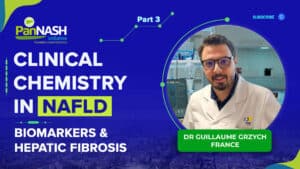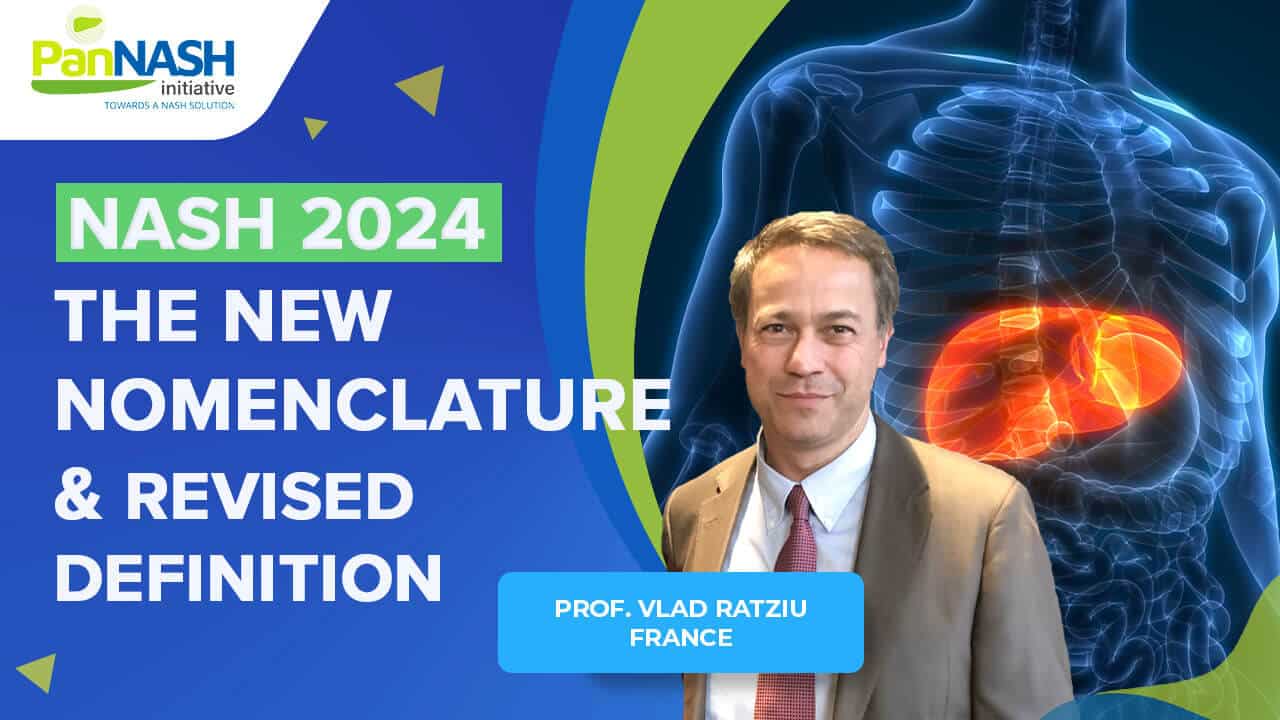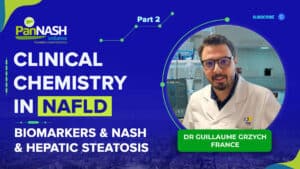NASH 2024: The New Nomenclature and Revised Definition
Introduction about Prof. Vlad Ratziu
Professor Vlad Ratziu is a renowned hepatologist at Sorbonne Université and Hôpital Pitié-Salpêtrière in Paris, France. A leading authority in non-alcoholic fatty liver disease (NAFLD) and liver fibrosis, Professor Ratziu has coordinated several influential research consortia, including the FLIP and the Horizon 2020 NASH EPoS.
As a prolific contributor to hepatology literature and a member of various editorial and advisory boards, his work continues to shape the understanding and treatment of liver diseases globally.
Overview of the New nomenclature and revised definition for NASH: why did we do it, and what it achieved
Table of Contents
- Introduction about Prof. Vlad Ratziu
- Overview of the New nomenclature and revised definition for NASH: why did we do it, and what it achieved
- Redefining Steatotic Liver Disease: Why a Nomenclature Change Now?
- Challenges with Current NAFLD Nomenclature
- Requirements for new nomenclature
- Essentials for a Refined Definition of Steatotic Liver Disease
- Establishing a Unified NAFLD Nomenclature: A Collaborative International Effort
- Refining NAFLD Definitions: The Delphi Process and Consensus Building
- Consensus Building in NAFLD Nomenclature: Key Areas of Agreement
- Areas of moderate consensus (<67%) up to R4
- Finalizing the Consensus on NAFLD Nomenclature
Redefining Steatotic Liver Disease: Why a Nomenclature Change Now?
As Prof. Vlad Ratziu discusses, the prevalence of steatotic liver disease has surged, particularly in Western countries and increasingly worldwide. Recognized as part of a broader metabolic phenotype, this condition is often underdiagnosed and insufficiently managed, transcending beyond academic interest due to the significant investment from various stakeholders, including industry and private organizations funding research.

With its growing prominence, there’s an urgent need for a standardized nomenclature that encapsulates all disease facets, including secondary conditions, dual etiologies, and cirrhosis stages.
Prof. Ratziu underscores the imperative for this shift in classification to enhance understanding, diagnosis, and management across the medical community. Therefore, the call for a new classification and nomenclature is both timely and critical in addressing the complexities of steatotic liver disease.
Challenges with Current NAFLD Nomenclature
Problems we are facing with the status-quo
Prof. Vlad Ratziu articulates several critical challenges inherent in maintaining the existing old nomenclature for steatotic liver disease:
- Non-based Definition: The current nomenclature defines the disease by what it isn’t, rather than what it is—a non-ideal approach that hinders scientific clarity and understanding.
- Low Awareness in At-Risk Populations: There’s a notable lack of awareness, particularly among patients with metabolic risk factors, as the condition’s nomenclature doesn’t effectively encompass or communicate its correlation with broader metabolic disorders.
- Inadequate Disease Categorization: The existing classification fails to adequately categorize individuals with different disease manifestations, such as those with ‘lean’ NAFLD, secondary causes of steatosis, or dual causes of liver disease, leading to a one-size-fits-all approach where it doesn’t apply.
- Ignoring Epidemiological Realities: The current definition, with its strict exclusion of alcohol consumption, overlooks the substantial population segment that has overlapping risk factors for both alcohol-induced and non-alcohol-related steatosis, failing to account for the complexity and variety of real-world scenarios.
- Increased Heterogeneity: The lack of precise and encompassing nomenclature leads to increased heterogeneity within the disease classification, muddying the waters around what specific pathogenic mechanisms are involved and how they differ across the disease spectrum.
- Insufficient Funding and Awareness: Due to its ambiguous and “non-” based nature, steatotic liver disease often receives less funding and attention compared to well-defined health conditions, exemplified by the disproportionate funding towards HIV research and intervention.
- Patient Understanding and Engagement: The current nomenclature leads to poor understanding among patients, often resulting in reluctance or hesitance to actively engage in managing their condition with healthcare providers due to a lack of clear, relatable, and actionable information.
Prof. Ratziu emphasizes the pressing need for a revised and more inclusive nomenclature that addresses these myriad issues, fostering better scientific understanding, patient awareness, and targeted treatment approaches.
Implications of NAFLD Nomenclature on Patient Perception
Prof. Vlad Ratziu addresses the significant negative implications that the current nomenclature, Non-Alcoholic Fatty Liver Disease (NAFLD), has from a patient perspective:
- Confusion and Trivialization: The term NAFLD, with its emphasis on what the disease is not (non-alcoholic), leads to confusion and trivialization among patients. This can diminish the perceived seriousness of the condition, leading to a lack of urgency in addressing it.
- Holistic Care Hindered: The current name doesn’t reflect the comprehensive metabolic implications of the disease, leading to a lack of holistic care. This means that the wider health impacts related to the metabolic aspects of the disease might be overlooked or underemphasized in patient treatment plans.
- Poor Quality of Life and Access to Care: The nomenclature’s failure to effectively communicate the disease’s nature and severity can result in poor quality of life for patients. It contributes to less access to appropriate health services and management strategies, exacerbating the disease burden and leading to worse health outcomes.

Prof. Ratziu suggests that a shift in nomenclature could significantly impact patient understanding, engagement, and ultimately, the management and prognosis of the disease. This shift is essential for ensuring patients receive comprehensive care that addresses all aspects of their condition.
Enhancing Understanding of NAFLD through Two Decades of Research
Prof. Vlad Ratziu elaborates on how over two decades of studies have refined our understanding of the pathogenesis of Non-Alcoholic Fatty Liver Disease (NAFLD):
- Origins of the ‘Non-Alcoholic’ Term: Initially, the term “non-alcoholic” was used to distinguish NAFLD from alcoholic liver disease due to similar pathological appearances. However, this term fails to encompass the significant metabolic comorbidities associated with NAFLD, underscoring the need for a more accurate descriptor.
- Limitations of ‘Nutrition-Associated’ Nomenclature: Alternative terms like “nutrition-associated” were considered but found inadequate as they oversimplify the disease by focusing solely on dietary factors and inadvertently blaming patients for their condition. NAFLD’s pathogenesis is far more complex, often involving genetic predispositions and other non-nutritional factors.
- Metabolic Dysfunction as a Key Determinant: Acknowledging metabolic dysfunction, particularly insulin resistance and adipose tissue dysfunction, is crucial. These elements are central to fat accumulation and inflammation in the liver, making metabolic risk factors critical for understanding NAFLD’s prevalence, severity, and potential oncogenic progression.
- Benefits of Metabolic Anchoring: Reframing NAFLD within the context of metabolic dysfunction can enhance disease detection, increase awareness, and streamline care and management strategies. It can also facilitate communication with healthcare authorities and funding entities, providing a clearer understanding of the disease’s nature and the need for targeted interventions.
- Severity and Metabolic Dysfunction: Identifying patients with severe metabolic dysfunction is vital, as it often correlates with the severity of liver disease. The metabolic risk factors associated with NAFLD are well-documented in cardiometabolic research, providing a foundation for identifying and managing those at greatest risk.
Through years of research, the understanding of NAFLD has evolved significantly, highlighting the need for an updated nomenclature and approach that reflects its multifaceted nature and metabolic roots. Prof. Ratziu’s insights emphasize the importance of recognizing the metabolic underpinnings of NAFLD to improve patient outcomes and guide future research and treatment strategies.
International Consensus on Metabolic Dysfunction-Associated Fatty Liver Disease (MAFLD)
Prof. Vlad Ratziu discusses the seminal 2020 initiative that led to a pivotal reclassification of Non-Alcoholic Fatty Liver Disease (NAFLD), marking a significant shift in understanding and managing the disease:
- Emergence of a New Definition: An extensive panel of international experts convened to re-evaluate NAFLD, recognizing the central role of metabolic risk factors. This effort culminated in a landmark publication led by Jacob George and colleagues, proposing the term Metabolic Dysfunction-Associated Fatty Liver Disease (MAFLD). This new nomenclature aims to more accurately reflect the disease’s association with metabolic dysfunctions.
- Expert Consensus and Criticisms: While the new definition marks a progressive step, it has not been without its detractors. Concerns primarily revolve around the process’s inclusivity and legitimacy, questioning whether the consensus represented a comprehensive spectrum of scientific opinion.
- Impact on Awareness and Stigma: Critics also point out that while the new term emphasizes metabolic dysfunction, retaining “fatty” in the disease title may continue to perpetuate stigma and misperceptions. There’s a debate over whether this change sufficiently shifts the narrative and patient perception of the disease.
- Implications for Drug and Biomarker Development: The redefinition’s broader criteria for daily alcohol consumption and the shift away from steatohepatitis as a distinct pathological entity raise questions about the future of drug development and biomarker specificity.
- Adaptability and Future Research: The clarity and adaptability of the term “metabolic dysfunction” are also under scrutiny. As our understanding of the disease evolves with ongoing research, there are concerns about how well the new classification can accommodate emerging disease phenotypes and nuanced patient profiles.

Prof. Ratziu sheds light on the complexities and controversies surrounding the reclassification of NAFLD to MAFLD. Despite the challenges and debates, this redefinition represents a critical step in aligning the disease’s nomenclature with its predominant risk factors and pathophysiology, paving the way for improved patient care, research, and awareness in the long term.
Requirements for new nomenclature
Prof. Vlad Ratziu articulates the need for a comprehensive and non-stigmatizing nomenclature for liver disease that accurately reflects its underlying causes and adapts to evolving scientific insights:
- Conveying Underlying Disease Drivers: The new terminology must clearly encapsulate the primary cause of the disease, predominantly metabolic dysfunction, to reflect the disease’s etiology accurately.
- Non-Stigmatizing Language: It is imperative to adopt a term that is sensitive across cultures and languages, avoiding stigmatization and misinterpretation by patients and the broader public.
- Incorporating Alcohol Consumption: The nomenclature should reasonably account for the role of alcohol, particularly considering moderate consumption, which is a common and significant factor in liver disease.
- Classifying Specific Etiologies: A more nuanced classification system is needed to categorize various causes leading to steatosis, ensuring that each specific etiology is adequately represented and understood in the broader context of the disease.
- Adapting to New Discoveries: As medical science progresses, the nomenclature should be flexible enough to incorporate new findings and shifts in understanding. This adaptability is crucial for staying current with advancements in diagnosis, treatment, and epidemiology.
Prof. Ratziu emphasizes that a reformed nomenclature is not just a semantic change but a necessary evolution to enhance the accuracy of diagnosis, reduce patient stigma, and foster a deeper understanding of the disease across the medical community and public. This shift is seen as a critical step towards improving the global approach to liver health, research, and patient care.
Essentials for a Refined Definition of Steatotic Liver Disease
Prof. Vlad Ratziu provides insightful directives for updating the definition of steatotic liver disease, with a focus on clarity, inclusivity, and adaptability to ensure comprehensive and accurate diagnosis and management:
- Affirmative Diagnostic Criteria: The new definition should pivot from exclusionary criteria to a more affirmative set, clearly stating what constitutes steatotic liver disease. This approach ensures that the disease is identified based on its own characteristics rather than the absence of others.
- Inclusive Approach: The revised definition must be broad enough to encompass all potential patients, including those with early, minor, or atypical forms of the disease. Ensuring no patient is overlooked due to overly narrow criteria is crucial for comprehensive care.
- Reducing Patient Heterogeneity: While aiming to be inclusive, the definition should also seek to minimize patient heterogeneity. This balance is vital for maintaining a clear understanding of the disease and ensuring that treatment and management strategies are effectively tailored.
- Simplicity and Accessibility: The definition should be straightforward and utilize parameters that are easily measurable worldwide. This universal accessibility is essential for ensuring that diagnosis and subsequent care are available globally, regardless of location or resources.
- Alignment with Established Metrics: The diagnostic criteria should be aligned with well-established and validated measurements of cardiometabolic risk factors. This alignment ensures consistency and reliability in diagnosis and treatment, leveraging the robust findings and methodologies from related medical fields.
- Consideration for Pediatric Population: Any set of criteria developed for adults should be appropriately adjusted to suit the pediatric population. Children present unique physiological and developmental factors that must be considered to ensure accurate diagnosis and effective treatment.
By addressing these requirements, Prof. Ratziu advocates for a definition that is not only medically accurate but also patient-centric and adaptable to the evolving landscape of liver health research and clinical practice. The ultimate goal is to ensure that patients worldwide receive timely, accurate diagnosis and effective management for steatotic liver disease.
Establishing a Unified NAFLD Nomenclature: A Collaborative International Effort
In a move to address the complexities and evolving understanding of Non-Alcoholic Fatty Liver Disease (NAFLD), international scientific societies have embarked on a significant journey to redefine and standardize the nomenclature for NAFLD. Here’s an overview of this comprehensive initiative:

- Expert Panel Convening: A select panel of renowned experts in liver disease has been assembled to spearhead the initiative. This team is tasked with developing a new, more accurate, and universally acceptable nomenclature and definition for NAFLD.
- Extensive Expert Consultation: To ensure the new nomenclature is robust and widely acceptable, the preliminary definitions and classifications are subjected to rigorous scrutiny through a Delphi process. This involves a larger group of 264 experts, including patient advocacy groups, from an impressive 56 countries, ensuring a diverse and comprehensive perspective.
- Global Involvement and Representation: The process is notable for its global reach, with participation from experts across various continents and regions, as depicted in the provided map. This wide-ranging involvement is crucial for the adoption and effectiveness of the new nomenclature, considering the global prevalence and impact of NAFLD.
- Steering Committee and Expertise: The steering committee, showcased in the presentation, comprises individuals who are not only experts in NAFLD but also influential figures in hepatology. Their extensive publication record and the significant impact of their research underscore the credibility and authority of this initiative.

This global effort signifies a major step towards harmonizing the understanding and approach to NAFLD, aiming to improve diagnosis, management, and awareness of the disease worldwide. The initiative reflects a commitment to enhancing patient care and research in liver diseases, with a keen focus on accommodating diverse medical perspectives and patient experiences.
Refining NAFLD Definitions: The Delphi Process and Consensus Building
The extensive undertaking to redefine NAFLD terminology employed a meticulous Delphi process, engaging a wide array of experts and patient representatives. Here’s a breakdown of the approach and its outcomes:
- Iterative Expert Consultation: The Delphi method utilized here involved iterative rounds of surveying, where a broad panel of 264 members, including experts and patient advocates, were presented with a series of statements related to NAFLD nomenclature. Their feedback and votes were crucial in shaping the subsequent rounds of discussion and refining the statements.
- Four Rounds of Refinement: The process was comprehensive, spanning four rounds of questions and adjustments. Each round was carefully designed based on the feedback and consensus levels from the previous one. Statements that garnered high consensus were carried forward, while those with insufficient agreement were either discarded or reworded for clearer consensus in future rounds.
- High Consensus Statements: A significant achievement of this process was the identification of statements that received robust agreement from the panel. These statements, indicating high consensus, provided a solid foundation for the new nomenclature and definitions moving forward.
- Public Discussions and Validation: The evolving consensus was not only built through private rounds of surveys but also through public discussions. Notable occasions included an ad hoc meeting in Chicago in July 2022 and a presentation at the Liver Congress in Washington D.C., hosted by the American Association for the Study of Liver Disease. These public engagements were vital for further refining the consensus and ensuring transparency in the process.

This rigorous, iterative method reflects a commitment to a democratic and inclusive approach in medical nomenclature redefinition, ensuring that the resultant terminology is both scientifically robust and widely acceptable to the community it serves. The methodology underscores the importance of multiple perspectives and expert inputs in shaping medical terminology, ultimately aiming to enhance understanding, diagnosis, and treatment of NAFLD across the globe.
Consensus Building in NAFLD Nomenclature: Key Areas of Agreement
Throughout the extensive Delphi process involving a broad panel of experts, several critical areas emerged where there was substantial consensus, shaping the future definition and understanding of NAFLD. These areas include:
- The Role of Alcohol in Disease Definition: There was strong agreement that alcohol consumption, even at moderate levels, significantly impacts the disease’s natural history and treatment responses. Experts concurred that moderate daily consumption, especially when coupled with metabolic risk factors, should be categorized distinctly due to its additive negative effects on liver health.
- Delineation of Alcohol Consumption Thresholds: The panel agreed on clear thresholds for alcohol consumption, distinguishing between moderate consumption and excessive intake. A daily consumption of 60 grams was identified as a pivot point, beyond which the condition aligns more closely with alcohol-related liver disease, necessitating its classification.
- Importance of Steatohepatitis: The term ‘steatohepatitis,’ indicative of liver inflammation and injury alongside steatosis, was underscored for its prognostic value. This condition, particularly driving fibrogenesis in the liver, should be a focal point in classifying disease activity and assessing therapeutic efficacy.
- Classification Based on Disease Activity: There was a consensus on the importance of distinguishing individuals with steatosis but without metabolic risk factors, often associated with secondary causes of steatosis. This differentiation is vital for accurate diagnosis and treatment planning.
- Metabolic Dysfunction as a Central Disease Element: The term ‘metabolic dysfunction’ resonated with the panelists due to its comprehensive encapsulation of the disease’s pathophysiology. Incorporating this term into the disease’s definition was seen as critical to reflecting its true nature and implications.
These consensus areas reflect a move towards a more nuanced, inclusive, and precise understanding of NAFLD. By acknowledging the role of alcohol, the distinct nature of steatohepatitis, and the pivotal aspect of metabolic dysfunction, the medical community is better equipped to classify, diagnose, and manage this increasingly prevalent disease. This collective agreement sets the stage for a more effective and targeted approach to managing NAFLD, emphasizing the importance of a nuanced understanding and classification to guide future research, policy, and treatment strategies.
Areas of moderate consensus (<67%) up to R4
During the comprehensive review process to redefine Non-Alcoholic Fatty Liver Disease (NAFLD) nomenclature, areas of moderate consensus highlighted the nuanced perspectives and the need for careful consideration in evolving disease terminology. Key points of moderate consensus include:
- Need for Nomenclature Change: A significant portion of the panel, over three-quarters, agreed that the current names NAFLD and NASH are flawed enough to necessitate a change. This reflects a strong inclination towards redefining the disease to better align with current understanding and terminology that accurately reflects its nature and implications.
- Adoption of an Umbrella Term: Nearly 80% of the panelists concurred that a comprehensive umbrella term should be adopted. This term would encompass the various forms of steatosis, categorizing them based on their underlying etiological factors. This suggests a move towards a more inclusive and descriptive naming system that reflects the multifaceted nature of the disease and its various origins.
- Impact on Clinical Trials: The panelists debated the implications of a nomenclature change on ongoing and future clinical trials. The prevailing view was that the impact would be negligible, indicating a belief that while the disease’s name might evolve, the foundational aspects of research and treatment would remain stable, allowing for continuity and comparability in clinical trials.
These areas of moderate consensus reflect a collective acknowledgment of the complexities and evolving understanding of NAFLD. While there is a strong drive towards
Finalizing the Consensus on NAFLD Nomenclature
The consensus-driven nomenclature process for Non-Alcoholic Fatty Liver Disease (NAFLD) concluded with the establishment of an encompassing term, “steatotic liver disease,” marking a significant shift in the medical community’s approach to understanding and categorizing liver diseases associated with fat accumulation. The reclassification under this new nomenclature includes:
- Metabolic Dysfunction-Associated Steatotic Liver Disease (MASLD): This category addresses cases where metabolic risk factors are predominant. MASLD is further subdivided based on the disease’s severity and characteristics:
- MASLD with Steatohepatitis: This subcategory refers to conditions where liver inflammation and cell injury coexist with steatosis.
- MASLD (Simple Steatosis): This designation is for cases of steatosis without the accompanying inflammation or liver cell injury.
- Alcohol-Related Liver Disease (ARLD): This category is explicitly reserved for liver diseases primarily caused by excessive alcohol consumption, distinguishing them from metabolic and other etiologies.
- Specific Etiologies of Steatotic Liver Disease: This grouping accommodates liver diseases caused by identifiable factors other than metabolic dysfunction or alcohol, including drug-induced liver disease, rare genetic disorders, and other specific environmental factors leading to fat accumulation in the liver.
- Cryptogenic Steatotic Liver Disease: This term is used for cases where the underlying cause of liver steatosis remains unidentified, labeling them as cryptogenic until further discoveries might shed light on specific causes.
- Metabolic-Alcohol Related Liver Disease (MetALD): A novel category recognized in the new nomenclature, MetALD refers to cases where both moderate alcohol consumption (between 20-50 grams per day) and metabolic risk factors are present. This category acknowledges the epidemiological significance of individuals who may not fit neatly into metabolic or alcohol-related categories alone.
This refined nomenclature aims to provide a more precise, patient-centric, and non-stigmatizing language for liver diseases associated with fat accumulation. It reflects the complexity and varied etiology of these conditions, emphasizing the need for specificity in diagnosis and treatment strategies. By adopting these terms, the medical community moves towards a more nuanced understanding of liver diseases, fostering better patient communication, targeted research, and improved clinical care strategies.
Article currently undergoing finalization.






